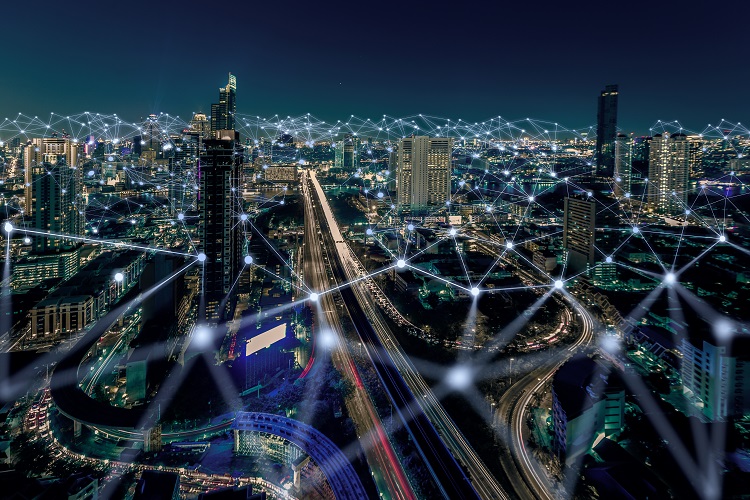 Smart city and dot point connect Modern Telecom System ,Boundless connection technology concept.Blue tone
Smart city and dot point connect Modern Telecom System ,Boundless connection technology concept.Blue tone
Fiber optic, broadband Internet and 5G
29. June 2023 Published by Raphael DoerrGermany is going flat out when it comes to expanding fiber optic networks, and aims to achieve the digital revolution with its current Gigabit Strategy. “Home office, streaming on board an ICE, and network access from a chalet in the mountains finally need to be possible without any difficulty. For that, we require powerful digital infrastructures everywhere, in other words, fiber optic into the home and the latest mobile standard.” So said Volker Wissing, Federal Minister for Digital and Transport, after the German government adopted the Gigabit Strategy. The aim of the German government is to triple the number of fiber optic connections by the end of 2025. 50 percent of households and companies should then be connected to the network via fiber optic cable. In mobile communications, uninterrupted voice and data communication nationwide should be achieved by 2026.
According to the German “Tagesschau” news show, however, many German households only have fast connections on paper. The fact is that they must regularly contend with network restrictions and interruptions. That’s what the third edition of the Deloitte “Broadband Consumer Survey” reveals, for which around 2,000 consumers in Germany were surveyed in March 2023. 27% of the respondents said that their broadband connection was unstable or slow at least once a month. Based on that, you might think that Germans were fed up of slow networks and permanent interruptions. In fact, the opposite is true.
Better than its reputation
Consumers in Germany across the board give their communication networks a mostly positive rating. The high level of satisfaction among German consumers with their broadband providers even went up further in 2023. Eight out of ten consumers give their Internet provider a basically positive rating, which is eight percentage points more than in the previous year.
It’s striking that the need for very high bandwidths is still very low, and is rising only slowly, even though the share of connections with 250 Mbit/s went up to 26 percent in 2023. The stability of the connection and a favorable price are decisive criteria for future Internet connections for customers and have top priority (78%), while only one in two respondents specify download speeds as a decisive criterion (48%).

Source: Staista
Even though experts expect the need for permanently fast and powerful broadband connections to increase in the future, there is currently still very little sign of that. According to the Deloitte survey, the demand by consumers for super fast gigabit connections is sluggish. That’s due to the relatively high price: 42 percent said that these connections were too expensive for them. Only 13 percent said that they would opt for a Gigabit connection at an acceptable price. In Europe, countries such as the Netherlands, Norway and Switzerland are the leaders when it comes to broadband expansion. The penetration rate in both countries is 99%. Germany cannot compete with that and, with just 89%, ranks in the lower midfield, even behind Albania.
Fiber optic expansion is on its way – but slowly
According to a report by the German Federal Network Agency, there are currently around 3.4 million active fiber optic connections in Germany. However, according to data from the OECD, only 8.1 percent of all stationary broadband connections in Germany are connected with a fiber optic cable. Austria, Belgium, and Greece are the only three OECD countries where the percentage is even lower. That currently puts Germany in 36th place in the country rankings, still behind Costa Rica and Colombia. The absolute world leader is South Korea with an optic fiber share of around 87 percent. In the top spot in Europe is Spain, with 81 percent.
Nevertheless, fiber optic is slowly but surely winning out among consumers over DSL, mobile, and TV cable, as the results of the Deloitte survey show.

Source: Deloitte
5G and fiber optic
One reason for that is certainly also 5G technology. From video chats on the go to music streaming, smartphones are part of everyday life. To cover the growing need for mobile communication, and speed up mobile Internet, Germany is focusing on the fifth mobile generation (“5G”). The new technology enables even large volumes of data to be transmitted practically in real time. The basis for high-speed mobile communications is a successful connection via fiber optic cable. No matter whether out in the countryside or at a company, fiber optic cables are the basis for high-speed mobile communication, since a single transmission mast with 5G technology sometimes only covers a few 100 meters. That means that the new mobile network comprises numerous small cells. The new mobile base stations should ideally all be connected to the core network via fiber optic cable.
The Gigaset 5G smartphone
The new Gigaset GX6 is without a doubt the classiest outdoor smartphone on the market and supports the fast 5G mobile standard. No more choppy connections, everything runs smoothly: streaming services, online games, downloads, navigation apps. Thanks to its 2.4 GHz MediaTek Dimensity 900 5G octa-core processor, users can surf, listen to music, or stream without any difficulty.
Do the test: with the broadband speed checker (“Breitbandmessung” desktop app). Here you can find out the actual data transmission rate for Internet access and compare it with the contractually agreed rate. For mobile testing, please use the dead spot checker app (Breitbandmessung/Funkloch-App).
 Comments
Comments
 en
en 







